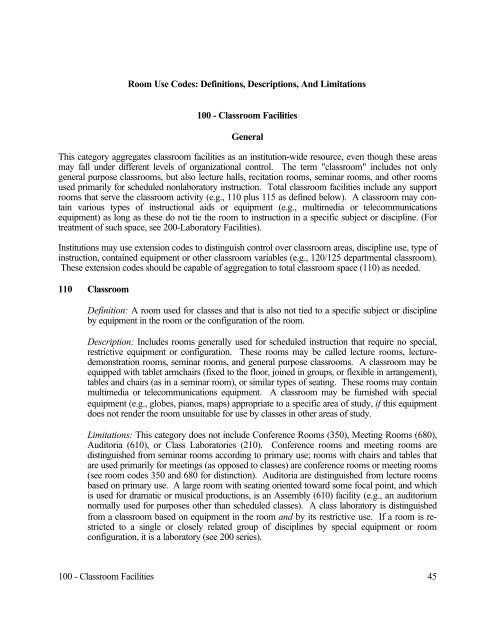Room Use Codes & Definitions
Room Use Codes & Definitions
Room Use Codes & Definitions
Create successful ePaper yourself
Turn your PDF publications into a flip-book with our unique Google optimized e-Paper software.
<strong>Room</strong> <strong>Use</strong> <strong>Codes</strong>: <strong>Definitions</strong>, Descriptions, And Limitations100 - Classroom FacilitiesGeneralThis category aggregates classroom facilities as an institution-wide resource, even though these areasmay fall under different levels of organizational control. The term "classroom" includes not onlygeneral purpose classrooms, but also lecture halls, recitation rooms, seminar rooms, and other roomsused primarily for scheduled nonlaboratory instruction. Total classroom facilities include any supportrooms that serve the classroom activity (e.g., 110 plus 115 as defined below). A classroom may containvarious types of instructional aids or equipment (e.g., multimedia or telecommunicationsequipment) as long as these do not tie the room to instruction in a specific subject or discipline. (Fortreatment of such space, see 200-Laboratory Facilities).Institutions may use extension codes to distinguish control over classroom areas, discipline use, type ofinstruction, contained equipment or other classroom variables (e.g., 120/125 departmental classroom).These extension codes should be capable of aggregation to total classroom space (110) as needed.110 ClassroomDefinition: A room used for classes and that is also not tied to a specific subject or disciplineby equipment in the room or the configuration of the room.Description: Includes rooms generally used for scheduled instruction that require no special,restrictive equipment or configuration. These rooms may be called lecture rooms, lecturedemonstrationrooms, seminar rooms, and general purpose classrooms. A classroom may beequipped with tablet armchairs (fixed to the floor, joined in groups, or flexible in arrangement),tables and chairs (as in a seminar room), or similar types of seating. These rooms may containmultimedia or telecommunications equipment. A classroom may be furnished with specialequipment (e.g., globes, pianos, maps) appropriate to a specific area of study, if this equipmentdoes not render the room unsuitable for use by classes in other areas of study.Limitations: This category does not include Conference <strong>Room</strong>s (350), Meeting <strong>Room</strong>s (680),Auditoria (610), or Class Laboratories (210). Conference rooms and meeting rooms aredistinguished from seminar rooms according to primary use; rooms with chairs and tables thatare used primarily for meetings (as opposed to classes) are conference rooms or meeting rooms(see room codes 350 and 680 for distinction). Auditoria are distinguished from lecture roomsbased on primary use. A large room with seating oriented toward some focal point, and whichis used for dramatic or musical productions, is an Assembly (610) facility (e.g., an auditoriumnormally used for purposes other than scheduled classes). A class laboratory is distinguishedfrom a classroom based on equipment in the room and by its restrictive use. If a room is restrictedto a single or closely related group of disciplines by special equipment or roomconfiguration, it is a laboratory (see 200 series).100 - Classroom Facilities 45
















